
Star Wars: The Force Unleashed
Written by: Rik
Date posted: October 7, 2022
- Genre: Action
- Developed by: LucasArts/Aspyr
- Published by: LucasArts
- Year released: 2009
- Our score: 6
There are lots of daft names for things in sci-fi in general and Star Wars in particular, many of which don’t deserve much further scrutiny or analysis. However, when the name of LucasArts’ big new secret Star Wars project – one that was going to restore their reputation as a developer, explore potentially fertile plot ground between the prequel and original trilogies, and convince Episode I-III naysayers that the franchise they loved was Back with a capital ‘B’ – was revealed as ‘The Force Unleashed’, all I could think about was an old Charlie Brooker cartoon in PC Zone that featured Darth Vader breaking wind in a pub (“Christ! The Force was strong in that one, boys!” was, I think, the caption).
It’s childish, I know. I’m 41 now and even 13 years ago was far too old and respectable to imagine doing a loud fart, announcing “Eh up, it’s The Force Unleashed!” and finding it funny, but we are where we are. To be fair, though, it did all sound reasonably exciting, even if at one point it was strictly a console-only title, and seemingly destined to occupy the kind of “ooh, that looks good/ah, it’s probably muck” mixture of envy/jealousy among PC gamers of a certain mindset.
It made it eventually, though, and as far as we’re concerned, having had a reasonably Star Wars-heavy year on FFG, including a look back at two different generations of SW action game seven years apart, it seemed like a good time to fast forward and see what was being offered up another seven years later. This does of course involve abandoning our iron-clad commitment to covering related games in chronological order, but after finding the Jedi Knight series a bit of a struggle, Jedi Academy might have to wait a little longer (or forever).
So, The Force Unleashed, then. We’re at that point in the timeline when Anakin Skywalker has become Darth Vader, but as of yet there is no Death Star, and no Rebel Alliance. Top of Vader’s to-do list is the hunting down and extermination of any remaining Jedi, and during an introductory playable sequence, you take charge of the Dark Lord himself as he strides insouciantly through a battle on [Wookie homeworld] Kashyyk, seemingly impervious to the combat raging all around, and pausing only to summon the power of the dark side to choke, grab and hurl into the sky any advancing Wookie soldiers.
The immediate message for the game ahead is: you are going to be a double-hard bastard who will be able to use a range of Force powers at will in order to overcome waves and waves of enemies. The dark side is, after all, supposed to be the quick and easy path, and doesn’t involve fannying about learning and controlling new skills, but summoning your hate and anger, with extreme haste, in order to pulverise any and all who stand in your way. Where some previous Star Wars games gave a (somewhat underpowered) sense of using The Force, this is literally The Force… Unleashed (parp!) – with a number of cool powers at your fingertips almost from the start.
After despatching the end-of-level Jedi, through a boss-battle sequence that is portentous of a slightly less welcome recurring feature, Vader discovers a small boy who is, surprise surprise, strong in The Force and immediately considered eligible for further training as his apprentice. Flash forward some years and it is the grown-up version of this apprentice, known as Starkiller, whom you control, and his immediate task is to continue Vader’s work in tracking down and killing potential Jedi stragglers.
The basic structure is: watch cutscene, go to new world, obliterate hundreds of enemies while destroying a good bit of the scenery too, then do a mildly tedious boss battle. Even though early level Starkiller isn’t quite on the same level as Vader, he can still do a lot of grabbing and throwing, whether it’s picking up an enemy directly and tossing him against the wall or off a ledge, or hurling barrels and crates – which may or may not be explosive – at assembled baddies. This is the late 00s era of Havok physics, too, and so there’s a surfeit of bouncing objects and debris, all of which are lacking a sense of heft, as if you’re throwing a giant exploding Malteser at someone rather than a big barrel full of liquid.
All of these pushing and throwing moves use up a limited supply of overall Force power, and so you may need to occasionally revert to the trusty old lightsaber, here very much a backup weapon. Almost to emphasise this, Starkiller carries his laser sword in a casually edgy manner which nevertheless resembles a waiter at an Italian restaurant concealing a giant black pepper grinder behind his back, ready to thrust it theatrically into waiting diners’ faces at a moment’s notice.
The realisation soon dawns that this is very much a beat ’em up/brawler style of game, or as my primitive brain would put it, ‘what Double Dragon might be like if it was made 20 years later’. There’s jumping, there’s whacking, there’s mixing up moves, and there’s hacking through the level until you get to the inevitable boss character. According to those who know more than me, series like Dynasty Warriors, Devil May Cry or God of War would be appropriately contemporary reference points.
Occasional puzzles present themselves, which usually involve the use of Force grip or push to move or change some bit of scenery, helpfully highlighted in a glowing blue, while sometimes trying to fend off attacks from a not insignificant number of enemies. But, generally, it’s crash-bang-wallop stuff, at least on the lower to medium difficulty settings (I played on the default, known as Sith Warrior, which is the second easiest of four). Your Force restores automatically over time, while health is replenished through defeating enemies, and pickups are limited to Jedi (extra points or powers) and Sith (temporary boosts to health, invulnerability etc) holocrons dotted around each map.
Progression brings opportunities to level up your character, learning new powers and allocating points to your favourites as appropriate, along with separate points categories for health and Force regeneration, and new combos for use in battle. Yes: I said combos, which apparently are what people who don’t just repeatedly and randomly hammer the controls use in these games. I must admit that the days of memorising long sequences of button presses are long gone, although there are a couple of easy ones that come in handy, and these, coupled with the wide variety of generic moves, from warping and jumping, to lightning, to pushing and repelling enemies, still make you feel like a badass even though you aren’t busting out fast finger combos.
Boss battles are the usual combination of epic visual scenes and fairly tedious gameplay. Each big bad has some powerful, but fairly well-telegraphed, moves that can put an end to you fairly quickly if not dodged or evaded, as well as some vulnerabilities of their own to be exploited. Swiping hopefully with the lightsaber won’t get you very far on its own, although it’s certainly something to resort to in anger if you’re on your way to a terminal beating. Quick time events also supplement the main action, with a bit of button bashing occasionally required mid-battle to resolve a lightsaber grapple or an instance where you both happen to be using the same Force powers on each other. Mainly, though, they’re used when finishing off an ailing enemy, inputting a series of fairly simple button presses when prompted while watching the climax of the battle.
I didn’t personally mind the QTEs, which provide a theatrical ending to some otherwise fairly clunky and non-choreographed action, although the boss bits in general aren’t the best, taking the fun out of being a mega-powerful Sith man, and bogging you down in some fairly turgid duelling. However, the sequence which seems to have attracted most ridicule over the years, involving Starkiller pulling a Star Destroyer out of the sky, I actually found quite dramatic and exciting, wrestling with the controls to focus on dragging down the big ship while periodically breaking off to dodge and attack waves of TIE Fighters.
Speaking of controls, they’re fairly obviously designed for an Xbox controller, although you can use mouse and keyboard. I abandoned the latter after completely failing to grip and lift a large piece of scenery on an early level and spending a not inconsiderable amount of time trying to figure out if it was a bug. The controller seems more natural all round, even if like me you’re the kind of doofus who can’t get his head around playing an FPS with the twin sticks. On the negative side, the third person camera is completely manually controlled, which is a bit of a pain, as you’re constantly distracted trying to swivel the right stick while trying to ward off whatever’s attacking you.
General Star Wars vibes are mixed: like many other SW games, it suffers from having to come up with new worlds and settings that convince as much as the familiar ones that draw more directly from the movie universe. In other words: running through a TIE Fighter factory is one thing, flopping into primitive vegetable land to fight Shamen is another. Raxus Prime is a standout, although it does draw some inspiration from [checks internet] the planet of Mustafar which featured at the end of Revenge of the Sith.
In terms of the story, I’m not one to take these things too seriously, but The Force Unleashed suffers for a basic premise which requires you to believe that a previously unheard of character had a big part in some fairly important events that are never spoken about ever again. The cut-scenes are video clips rather than in-engine, which makes them feel slightly dated, while the characters all have an unconvincing mannequin quality with slightly weird eyes in particular. Starkiller has a slightly sulky nu-metal energy, and has the look of a guy you vaguely remember who was in that thing you didn’t really like. Sprinkling in appearances from movie series big hitters (and that’s characters, rather than actors, in most cases), rather than delivering big wow moments, more often feels a little bit desperate.
The PC port is fairly bare bones, and locked at 30 fps, if such things bother you (if it does, then unlocking it apparently does weird stuff to the physics). The Ultimate Sith Edition on PC includes, among other things, three bonus DLC missions, two of which place Starkiller in an alternative version of key scenes on Hoth and Tattooine from the first two films (the other supplements the main Force Unleashed story, and involves exploring Starkiller’s origins). It’s classic fan-bait stuff, for sure, but also fairly enjoyable to see a new twist on the familiar, although depending on your perspective some of the guest star appearances border on the sacrilegious. (These missions arguably look better than the rest of the game, too, by ditching the video and using the game engine to tell the story).
Overall, The Force Unleashed is broadly fine, and occasionally a little bit better than that. Doing Force-based things to duff up a load of baddies in creative ways takes a while to get old, even if you’re a bit crap and just end up spamming the fizzy lightning powers a bit too much. And sometimes it is necessary to be a bit more clever and low profile, darting out of site and hurling a few bits and bobs at enemies from a distance rather than jumping into a nest of heavily armoured foes and certain death: sometimes, just legging it past some baddies is also a viable option. Even some of the boss battles have their moments. It tends towards the lightweight and inconsequential at times, but things bounce along at a reasonable enough pace, and there’s some fun to be had along the way.
Obviously, The Force Unleashed never quite turned out to be the massive new hit game LucasArts wanted, even if there are those who might like it more than me (although I daresay some might like it quite a bit less, too). It reminds me of the kind of console title that might have demoed in GAME or HMV back in the day, chosen because it’s Star Wars and has an exciting premise, regardless of the overall quality of the game: I can definitely recall observing Masters of Teras Kasi on PS1 (apparently not very good), Rogue Squadron 2 on GameCube (apparently excellent) and Episode III: Revenge of the Sith on the PS2 (a mixed bag) all being played by some confident youth in one or other of the major gaming chains at some point. Doubtless watching some guy play a few minutes of The Force Unleashed (while wanting, but never daring to ask, to have a go) would have made it look pretty cool too. The reality *is* still kind of cool in places, but it’s a far from essential experience.

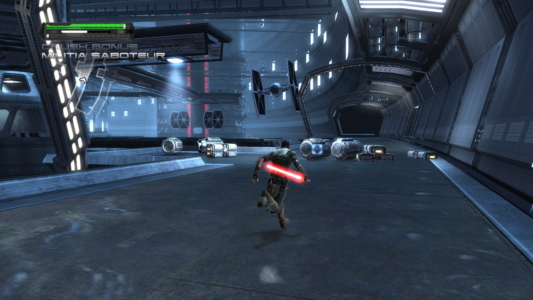
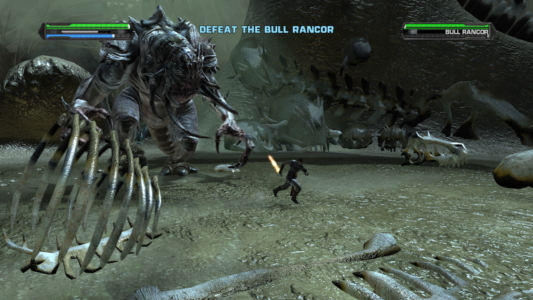
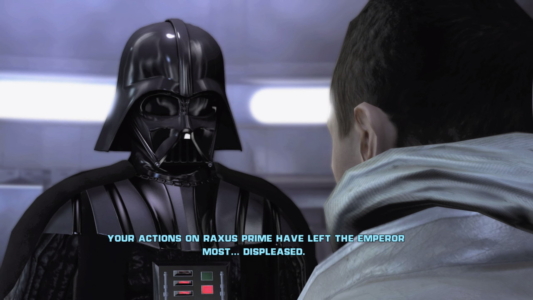
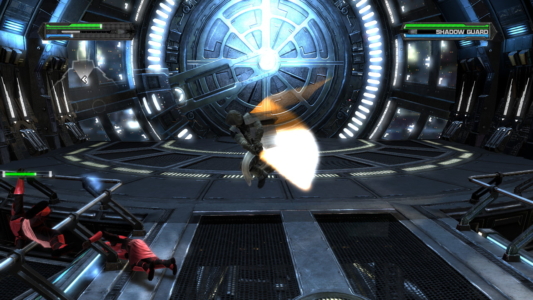
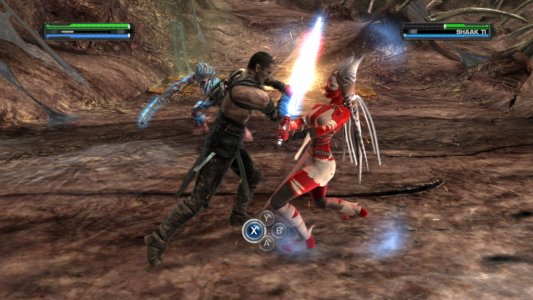
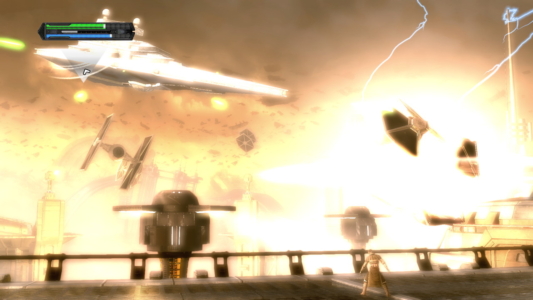

 Posts
Posts